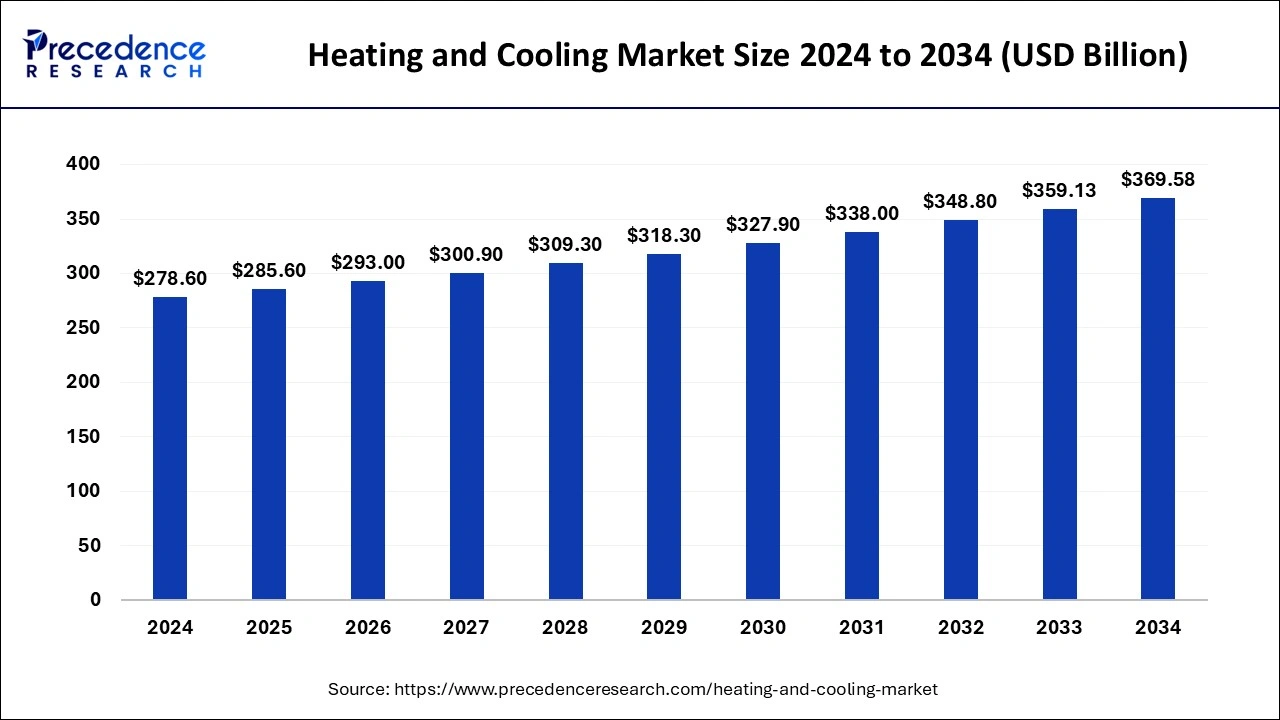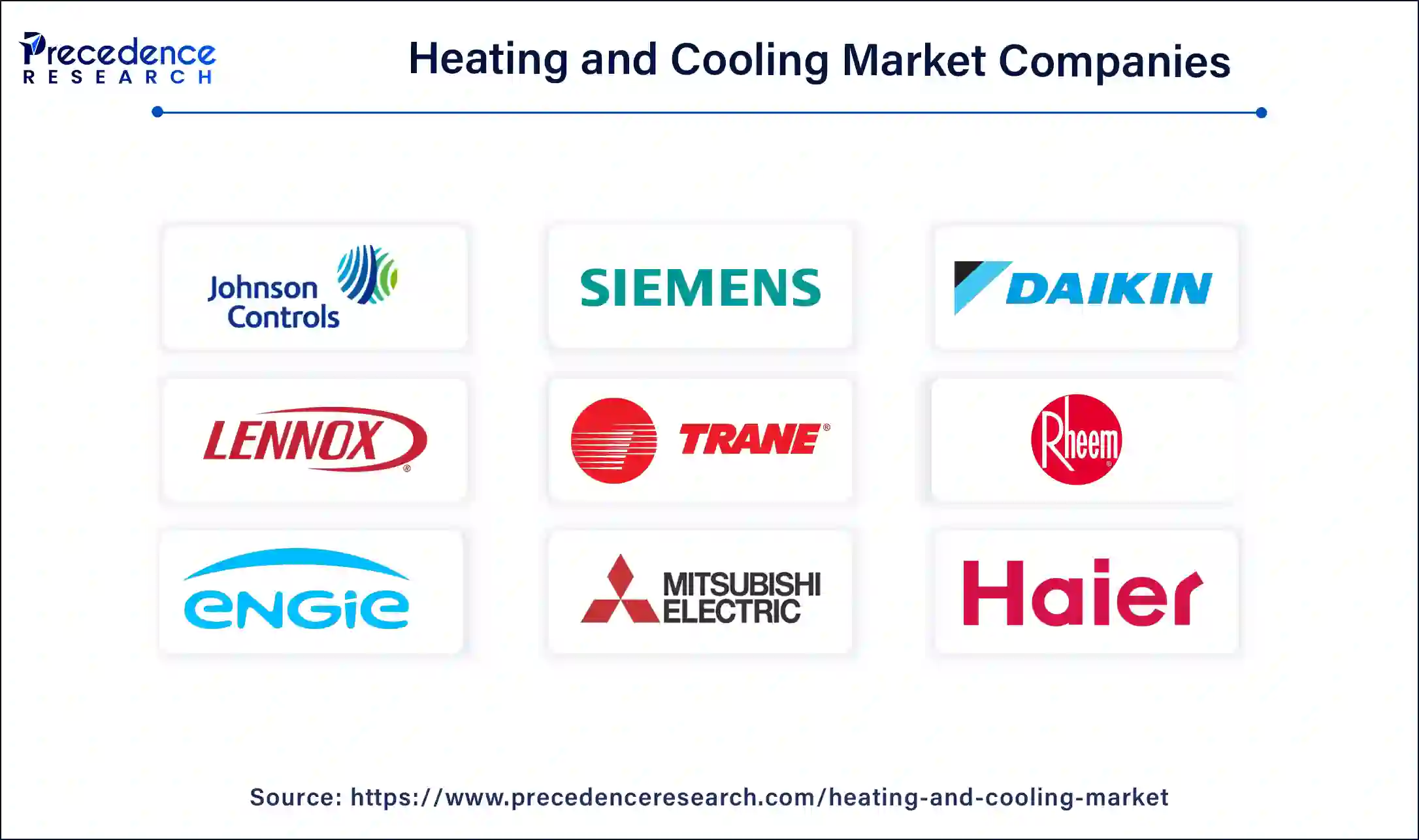May 2025
The global heating and cooling market size is calculated at USD 285.6 billion in 2025 and is forecasted to reach around USD 369.58 billion by 2034, accelerating at a CAGR of 2.87% from 2025 to 2034. The market sizing and forecasts are revenue-based (USD Million/Billion), with 2024 as the base year.
The global heating and cooling market size was accounted for USD 278.6 billion in 2024 and is anticipated to reach around USD 369.58 billion by 2034, growing at a CAGR of 2.87% from 2025 to 2034. The growth of the heating and cooling market is driven by the rising concerns about climate change and the increasing adoption of renewable energy sources.

The heating and cooling industry is experiencing a profound transformation driven by AI technologies. AI technologies have paved the way for the industry to develop smart heating and cooling systems. These systems analyze real-time data such as temperature and humidity levels using AI and ML algorithms to adjust temperature settings based on user preferences. This not only results in improved energy efficiency but also leads to significant cost savings for consumers. Moreover, AI's predictive maintenance capability predicts maintenance and reduces downtime, thereby optimizing the efficiency of heating and cooling solutions.
The market for heating and cooling centers on developing and distributing heating, ventilation, and air cooling (HVAC) systems, which control and create comfortable indoor environments for residential and commercial spaces. Due to the growing concerns about climate change, there is a strong emphasis on maintaining good indoor air quality. This, in turn, boosts the demand for HVAC systems due to their ability to provide adequate ventilation with filtration, significantly boosting the market's growth. The primary function of the HVAC system is to offer controlled ventilation in an effective and energy-efficient way.
The heating and cooling market includes two types of ventilation: wind-driven cross-ventilation and stack ventilation. The ventilation system plays a crucial role in maintaining proper air circulation and filtration of stale air and pollutants using exhaust fans and ventilation techniques. They are differentiated by the air densities they provide across space. Heating and cooling systems provide warmth during winter and maintain temperature during hot weather through furnaces, boilers, heat pumps, air conditioners, and evaporative coolers.
| Report Coverage | Details |
| Market Size in 2025 | USD 285.6 Billion |
| Market Size by 2034 | USD 369.58 Billion |
| Growth Rate from 2025 to 2034 | CAGR of 2.87% |
| Largest Market | North America |
| Base Year | 2024 |
| Forecast Period | 2025 to 2034 |
| Segments Covered | Category, Application, Region |
| Regions Covered | North America, Europe, Asia-Pacific, Latin America, and Middle East & Africa |
Rising Demand for Advanced Heating & Cooling Solutions
As the global population increasingly moves toward urban areas and individual incomes continue to rise, there is a corresponding surge in the demand for comfortable and aesthetically pleasing living environments. This growing preference for enhanced living spaces significantly boosts the demand for advanced heating and cooling systems, which are essential for maintaining indoor comfort, particularly in densely populated areas. In response to this escalating demand, developing and integrating energy-efficient technologies have become crucial. The rise of sustainable heat pumps that harness renewable energy sources, such as solar or geothermal, is driving the market growth. These eco-friendly systems are more energy-efficient and environmentally friendly than traditional HVAC systems.
High Cost
The initial costs associated with purchasing and installing HVAC systems can be considerable, creating a barrier for low and middle-income homeowners and small businesses who cannot afford such expenses. Moreover, the ongoing costs of maintenance and repairs can add up over time, particularly for older or less energy-efficient systems, which may require more frequent attention and replacement parts. In addition, certain refrigerants used in HVAC systems have been found to have detrimental effects on the environment. These substances contribute to ozone depletion and global warming, resulting in increased scrutiny and stricter regulations regarding their use. Regulatory bodies also impose restrictions that could further complicate the maintenance and operation of these systems.
Government Initiatives and Technological Advancements
Governments around the world have recognized the importance of energy-efficient technologies in supporting sustainability initiatives. Thus, they are implementing stringent energy efficiency regulations, encouraging manufacturers to develop energy-efficient heating and cooling solutions. Governments are also offering incentives and subsidies to offset the initial costs associated with upgrading or replacing older heating and cooling systems. Moreover, technological innovations, such as inverter technology, which controls the speed of compressor motors to match the required output, and smart thermostats that can be programmed or controlled remotely, optimize the functions of heating and cooling systems. These advancements greatly enhance the operational efficiency of heating and cooling systems, leading to reduced energy consumption and lower utility bills over time.
Based on the category, the heating segment accounted for more market share in 2024. The growing usage of floor heating in huge industries due to the extreme climate conditions has fueled the growth of this segment. Growing investments in urbanization and construction of huge buildings across industries is supporting the growth of the heating category. The increased demand for energy optimization and growing concerns related to the changing climatic conditions is significantly driving the growth of the heating segment across the globe. Moreover, the favorable government policies regarding the utilization of green energy is shifting the focus towards solar power, geothermal, solar PV, and biomass that would increase the utilization of sustainable sources of energy.
On the other hand, the rising surface temperature owing to the extreme climatic conditions in the equatorial regions is expected to foster the growth of the cooling segment during the forecast period. The global warming issues and rising number of hot climate days is fueling the demand for the efficient cooling solutions across the industries and residential applications that would enhance the energy consumption. Furthermore, the rising standard of living and demand for the luxurious lifestyle is significantly boosting the demand for the advanced cooling systems across the globe.
The residential segment dominated the global heating and cooling market in 2024. The surging demand for the efficient and effecting heating and cooling solutions pertaining to the regulatory frameworks that favors the HVAC systems in the residential sector has propelled the market growth. The encouragement regarding the green buildings is fostering the growth of the residential segment across the globe. The integration of the energy management systems across the residential sectors coupled with the rising real estate investments is augmenting the growth of the residential segment. The growing urbanization in the developing markets like Middle East, Asia Pacific, Latin America, and Africa is estimated to significantly impact the demand for the efficient heating and cooling systems in the forthcoming years, which will sustain the dominance of the residential segment throughout the forecast period.
North America dominated the global heating and cooling market in 2024. The rising integration of green energy sources along with the rising consumer expenditure on the residential and commercial sectors on the deployment of efficient cooling and heating systems is boosting the growth of the North America heating and cooling market. The rising living standards and increased demand for the luxury lifestyle is spurring the demand for the advanced heating and cooling systems. Moreover, the rising number of government initiatives to promote the adoption of renewable energy sources in the region is exponentially driving the market growth in North America. The rapid growth of the industries and the residential and commercial structures in North America has significantly driven the adoption of the advanced heating and cooling systems.
Asia Pacific is estimated to be the most opportunistic market during the forecast period. Rapid industrialization and rapid urbanization in Asia Pacific region is expected to boost the growth of the heating and cooling market. The increasing demand for the efficient heating and cooling systems owing to the elevated hot and cold climatic conditions across the Asia Pacific region is supporting the growth of the market. Moreover, the rising government initiatives to promote the adoption of green energy due to rising global warming issues is expected to foster the growth of the heating and cooling market during the forecast period.
The government plays a crucial role in the growth of heating and cooling market. The rising investments in the development and deployment of the renewable energy sources such as solar energy and wind energy is triggering the adoption of the green energy in the residential, industrial, and service sectors across the global markets.

By Category
By Application
By Geography
For inquiries regarding discounts, bulk purchases, or customization requests, please contact us at sales@precedenceresearch.com
No cookie-cutter, only authentic analysis – take the 1st step to become a Precedence Research client
May 2025